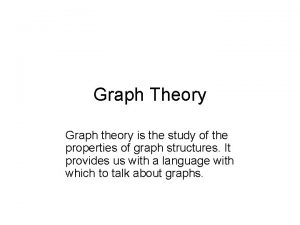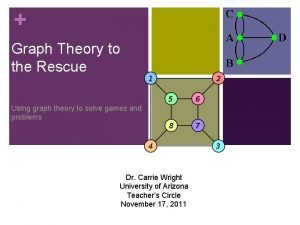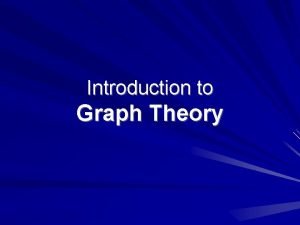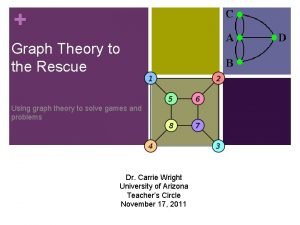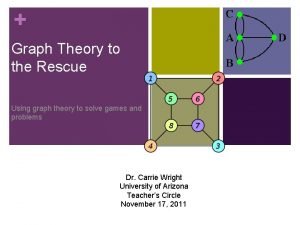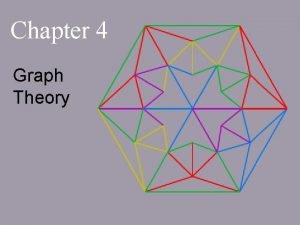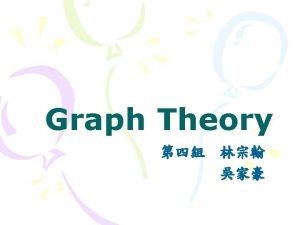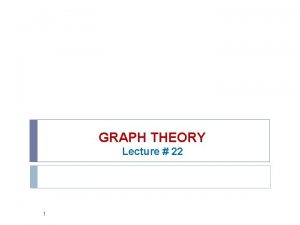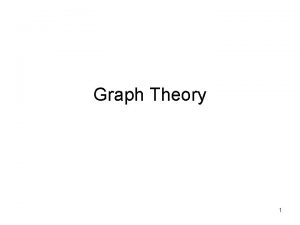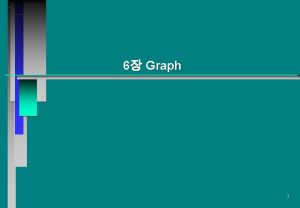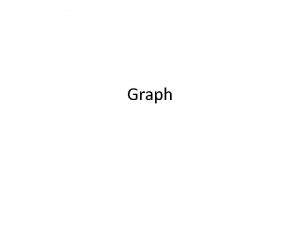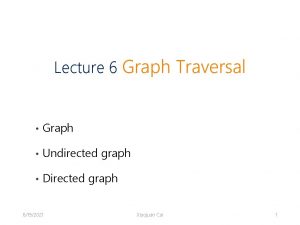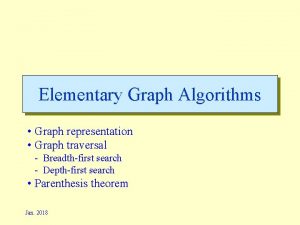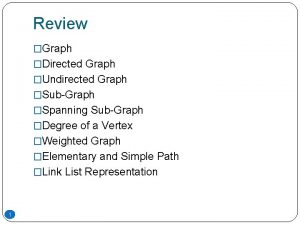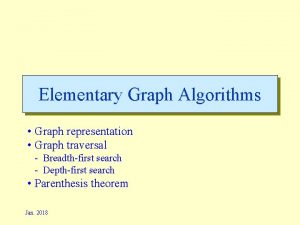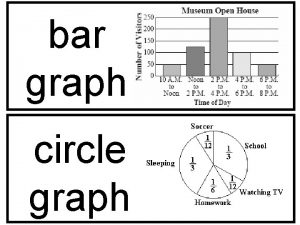Graph Theory Graph theory is the study of
























- Slides: 24

Graph Theory Graph theory is the study of the properties of graph structures. It provides us with a language with which to talk about graphs.

Degree • The degree of a vertex is the number of edges incident upon it. • The sum of the vertex degrees in any undirected graph is even (twice the number of edges). • Every graph contains an even number of odd-degree vertices.

Connectivity • A graph is connected if there is an undirected path between every pair of vertices. • The existence of a spanning tree is sufficient to prove connectivity. • The vertex (edge) connectivity is the smallest number of vertices (edges) which must be deleted to disconnect the graph.

Some terms • articulation vertex biconnected • bridge edge-biconnected • Testing for articulation vertices or bridges is easy via brute force.

Cycles • Eulerian cycle (path): a tour which visits every edge of the graph exactly once. • Actually, it is a circuit, not a cycle, because it may visit vertices more than once. • A mailman’s route is ideally an Eulerian cycle, so he can visit every street (edge) in the neighborhood once before returning home.

Eulerian Circuit http: //en. wikipedia. org/wiki/Eulerian_graph

• An undirected graph contains an Eulerian cycle if it is connected and every vertex is of even degree. • A Hamiltonian cycle is a tour which visits every vertex of the graph exactly once. • The traveling salesman problem asks for the shortest such tour on a weighted graph.

TSP http: //www. cs. princeton. edu/courses/archive/spr 05/cos 126/assignments/tsp. html

Planer Graph • Euler’s formula: n-m+f=2 • • • n: # of vertices m: # of edges f: # of faces Trees: m=n-1, f=1 Cubes: n=8, m=12, f=6

MST • Kruskal’s algorithm: starting from a minimal edge • Prim’s algorithm: starting from a given vertex – How about maximum spanning tree – and Minimum Product spanning tree

Kruskal’s Algorithm • Algorithm Kruskal(G) • Input:G=(V, E)為無向加權圖(undirected weighted graph), 其中V={v 0, …, vn-1} • Output:G的最小含括樹(minimum spanning tree, MST) • T← //T為MST,一開始設為空集合 • while T包含少於n-1個邊 do • 選出邊(u, v),其中(u, v) E,且(u, v)的加權(weight)最小 • E←E-(u, v) • if ( (u, v)加入T中形成循環(cycle) ) then 將(u, v)丟棄 • else T←T (u, v) • return T

Kruskal’s Algorithm -Construct MST

Prim’s algorithm • Algorithm Prim(G) • Input:G=(V, E)為無向加權圖(undirected weighted graph),其 中V={v 0, …, vn-1} • Output:G的最小含括樹(minimum spanning tree, MST) • T← //T為MST,一開始設為空集合 • X←{vx} //隨意選擇一個頂點vx加入集合X中 • while T包含少於n-1個邊 do • 選出(u, v) E,其中u X且v V-X,且(u, v)的加權(weight)最小 • T←T (u, v) • X←X {v} • return T



One-to-all shorted path • Dijkstra演算法: Dijkstra演算法屬於求取單一來源(source)至所有目 標(destination)頂點的一至多(one-to-all)最短路徑演算法





All-pair shortest path • Floyd-Warshall的所有頂點對最短路徑(all-pair shortest path)演 算法:



 Bridge graph
Bridge graph Hát kết hợp bộ gõ cơ thể
Hát kết hợp bộ gõ cơ thể Bổ thể
Bổ thể Tỉ lệ cơ thể trẻ em
Tỉ lệ cơ thể trẻ em Voi kéo gỗ như thế nào
Voi kéo gỗ như thế nào Tư thế worm breton là gì
Tư thế worm breton là gì Bài hát chúa yêu trần thế alleluia
Bài hát chúa yêu trần thế alleluia Môn thể thao bắt đầu bằng chữ f
Môn thể thao bắt đầu bằng chữ f Thế nào là hệ số cao nhất
Thế nào là hệ số cao nhất Các châu lục và đại dương trên thế giới
Các châu lục và đại dương trên thế giới Công thức tính thế năng
Công thức tính thế năng Trời xanh đây là của chúng ta thể thơ
Trời xanh đây là của chúng ta thể thơ Cách giải mật thư tọa độ
Cách giải mật thư tọa độ Làm thế nào để 102-1=99
Làm thế nào để 102-1=99 độ dài liên kết
độ dài liên kết Các châu lục và đại dương trên thế giới
Các châu lục và đại dương trên thế giới Thể thơ truyền thống
Thể thơ truyền thống Quá trình desamine hóa có thể tạo ra
Quá trình desamine hóa có thể tạo ra Một số thể thơ truyền thống
Một số thể thơ truyền thống Bàn tay mà dây bẩn
Bàn tay mà dây bẩn Vẽ hình chiếu vuông góc của vật thể sau
Vẽ hình chiếu vuông góc của vật thể sau Biện pháp chống mỏi cơ
Biện pháp chống mỏi cơ đặc điểm cơ thể của người tối cổ
đặc điểm cơ thể của người tối cổ Thế nào là giọng cùng tên?
Thế nào là giọng cùng tên?


























